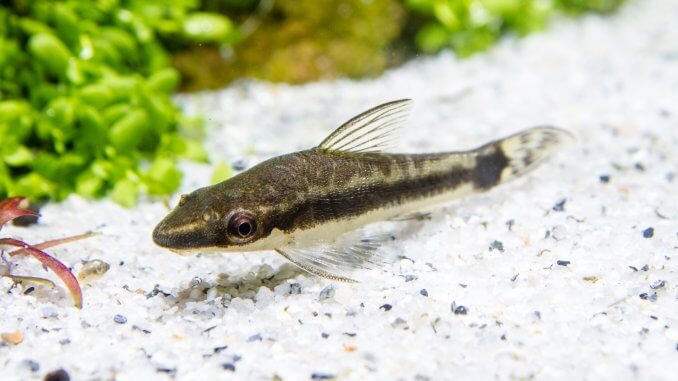
The otocinclus catfish is a freshwater fish of the catfish family. There are 22 known species of otocinclus catfish. These small fish grow up to 2 inches long and appear in various colors, usually with a horizontal brown stripe running along the fish’s bodies.
Otocincluses are peaceful, skittish fish that are popular amongst aquarists because of their algae-eating behavior. Although these fish are peaceful, they’re incompatible with large, aggressive, or predatorial tank mates.
TABLE OF CONTENTS
Otocinclus Catfish Facts & Overview
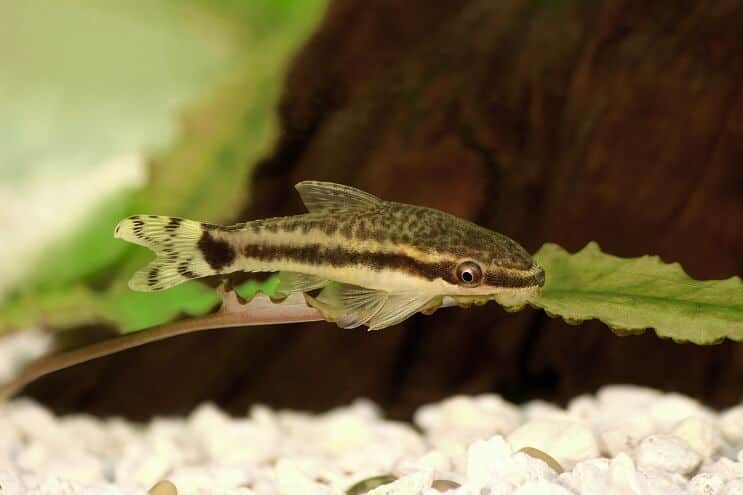
| Scientific name: | Otocinclus sp. |
| Common names: | Otocinclus, otocinclus catfish, dwarf sucker, dwarf armored catfish, oto, oto cat, otto |
| Distribution: | South America |
| Size: | 1–2 inches |
| Life expectancy: | 3–5 years |
| Color: | Various colors, usually with a horizontal brown stripe |
| Diet: | Herbivore |
| Temperament: | Peaceful |
| Minimum tank size: | 10 gallons |
| Temperature: | 72–79°F (22–26°C) |
| pH: | 6.8–7.5 |
| Hardness: | 7–15 dGH |
| Care level: | Easy |
| Breeding: | Egg-layer |
Origin
Otocinclus catfish are commonly found in slow-flowing shallow rivers and streams in South America.
In their wild habitat, the fish attach themselves to rocks, driftwood, and other stable surfaces to feed off algae. The waters in this habitat are moderately-vegetated, with good access to sunlight and a soft, sandy riverbed.
Adult Size & Lifespan
The otocinclus is a small fish that grows to 2 inches in length. Females are larger and broader than males when viewed from above.
The average lifespan of the oto catfish in captivity is 3–5 years, as long as the fish is cared for properly.
Availability
Otocincluses are a popular catfish species and are widely available in pet stores and online. Most stores at least sell common otos, and some sell other variations of otocincluses. The average cost of a common oto catfish is $3, and otos with unique patterns and markings cost between $13 and $18.
Reputable online stores that sell otocinclus catfish are:
- LiveAquaria (common otocincluses)
- Imperial Tropicals (common, zebra, giant otocincluses)
- Aquaticarts (common, orange zebra, alligator, giant otocincluses)
Appearance & Behavior
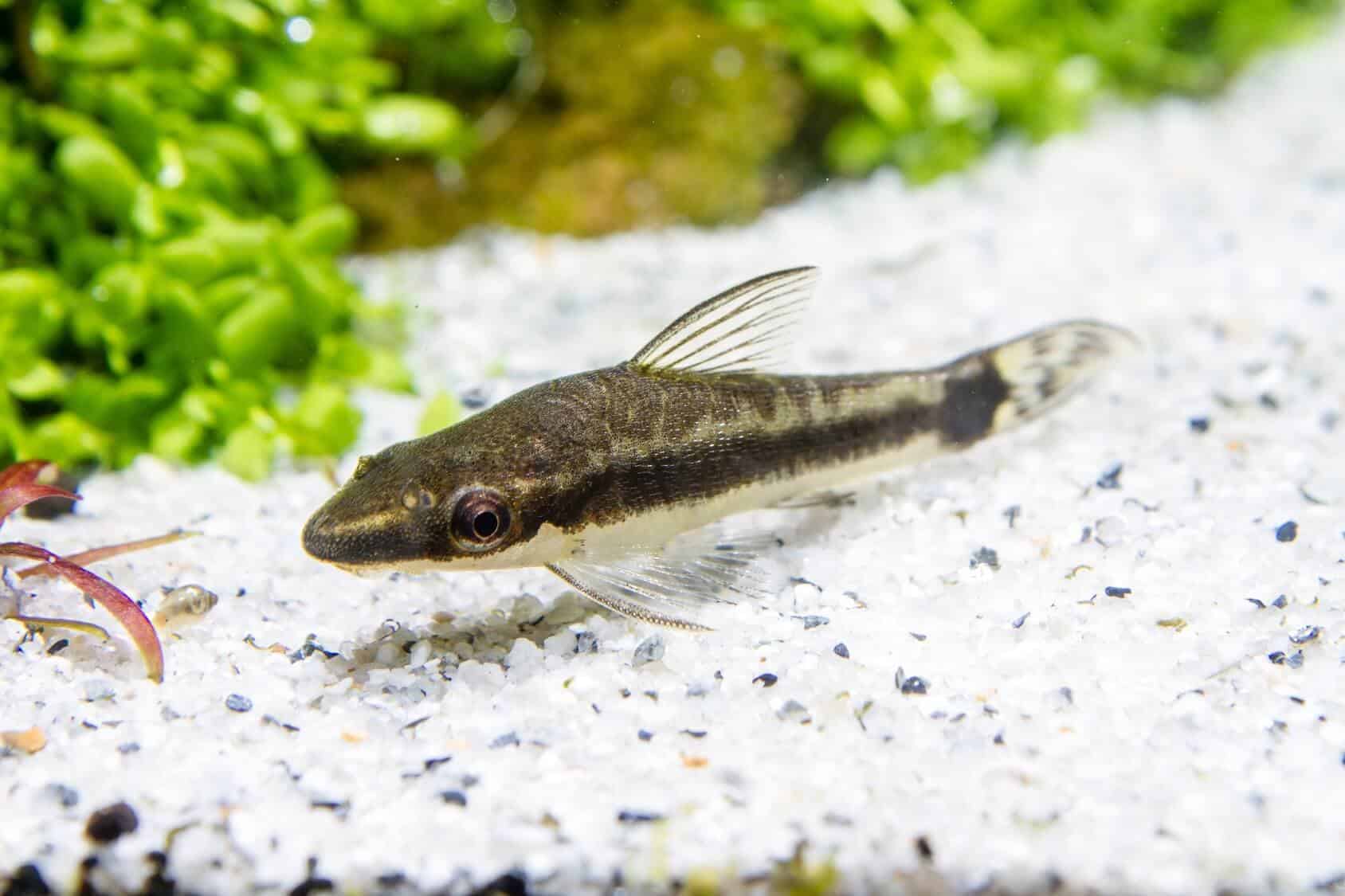
The otocinclus is a peaceful, nervous fish with a small, cylindrical-shaped body and a strong mouth that latches onto surfaces for feeding.
Colors, Patterns, Fins, and Sex Differences
Otocinclus catfish are small fish with narrow bodies, short fins, and powerful suckermouths designed for grazing on algae in flowing waters in the wild.
These fish are unique from other catfish species due to the rows of armor plating across their body, which protects them from other fish and rough surfaces. Oto catfish have a hollow space between the esophagus and stomach that gives them a limited ability to breathe air above the water’s surface.
Different types of oto catfish have different colors and patterns. Some of the most popular otocincluses are:
- Common Otocinclus: The most widespread oto catfish, with near-transparent fins, and a white lower body split from the speckled brown upper body by a horizontal brown stripe
- Golden Otocinclus: Similar in appearance to the common otocinclus, but with more gold-like coloring
- Zebra Otocinclus: An oto catfish that has vertical black-and-white zebra-like stripes from the head to the caudal fin. Appears in different color variations, including orange zebra
- Giant Otocinclus: Extra-large oto catfish species growing up to 4 inches long, with mottled brown or gray coloring
- Silver Otocinclus: An oto type that has the same lateral stripe as most other oto catfish species, but with brown coloration instead of silver
- Dwarf Otocinclus: Similar in appearance to the common otocinclus, but with a large blotch on the tail and a lateral stripe that becomes pale before reaching the caudal fin
- Alligator Otocinclus: Rare oto catfish species with mottled coloration in shades of black, brown, and gray
Regardless of the otocinclus’s coloration or patterning, the fish becomes duller than usual when stressed or housed in poor water conditions. Breeding fish are bolder and brighter than usual to attract mates.
Typical Behavior
Otocincluses are shy, reclusive fish with interesting feeding habits. The fish are fast-swimming and dart across the tank to take cover when they sense danger — they’re passive by nature and avoid conflict as much as possible.
Oto catfish are mainly nocturnal fish that spend most of their time latched by their mouths onto surfaces at the bottom of the tank, grazing on algae in groups. They get along well with other peaceful fish and are most confident when surrounded by other otos.
Otocinclus catfish occasionally swim to the surface of the water to breathe air, especially if oxygen in the water is lacking.
Oto Catfish Care & Tank Requirements
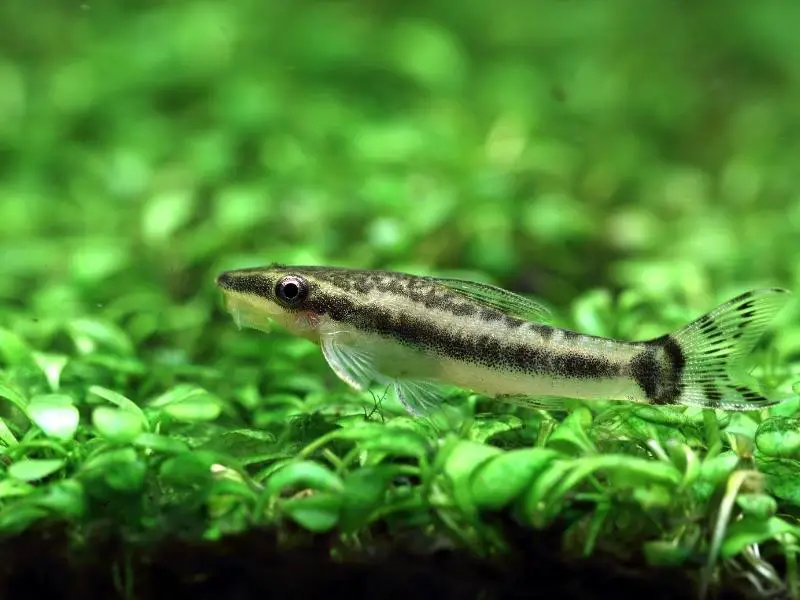
Caring for oto catfish is easy as long as you accurately mimic the fish’s wild habitat in captivity. Establish a warm, freshwater tank with slow-flowing water, and make sure the fish have plenty of access to algae.
Habitat and Tank Requirements
The otocinclus’s natural habitat is shallow, slow-flowing freshwater rivers and streams, with algae-covered surfaces and good access to sunlight. Replicate this habitat in the aquarium with a suitable substrate, decorations, and vegetation.
Choose a soft, fine-grain sandy substrate for the bottom of the tank. Oto catfish are bottom-dwellers that are known to dig in the substrate, so avoid coarse substrates that could injure the fish’s body.
Decorations like rocks, caves, driftwood, and plants like staurogyne repens can be used to encourage algae growth and provide shelter and hiding spots.
Standard aquarium lighting is fine, but to speed up algae growth, providing a bigger food source for otocincluses, place the tank in a spot that has access to direct sunlight during part of the day.
Tank Conditions
Ideal tank conditions for otocinclus catfish are:
| Water type: | Slow-flowing, soft, well-oxygenated freshwater |
| Tank size: | Minimum 10 gallons, or 20 gallons for groups of more than 10 fish |
| Water temperature: | 72–79°F (22–26°C) |
| Substrate: | Soft sand |
| Tank setup: | Plants, rocks, driftwood |
| Acidity: | 6.8–7.5 pH |
| Water hardness: | 7.0–15.0 dGH |
| Filter: | Yes. Oto catfish are sensitive to poor water quality, and a good filter is required to minimize nitrite and ammonia levels |
| Lighting: | Standard aquarium lighting |
| Water heater: | Yes, to keep the water warm |
| Bubbler: | Yes, although not essential. Can be used to oxygenate the water |
Otocincluses are hardy fish, but they don’t tolerate fluctuating water parameters, so keep the water conditions clean and stable to ensure the fish are healthy and stress-free.
Disease
There are no specific diseases affecting only otocinclus catfish, but the fish are prone to some common freshwater diseases.
Ich, or white spot disease, is the most common external parasite affecting oto catfish. This disease causes itchy, salt-like sprinkles on the fish’s body and fins. Fish with ich appear lethargic, rub their bodies against surfaces in the tank, and may lose their appetites.
Treat ich by quarantining the affected fish and adding commercial treatments or aquarium salts to the tank, following the instructions on the packet.
Tank Mates
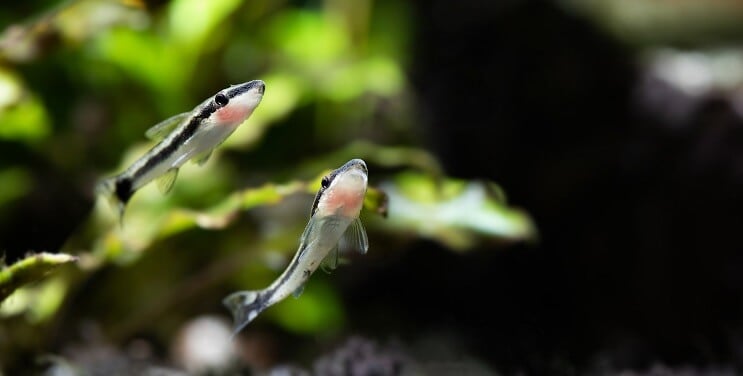
Otocinclus catfish are small, peaceful fish that are easy targets for large, predatory fish, like oscars and cichlids. Don’t house oto catfish with aggressive fish or fish that have large enough mouths to eat this small catfish species.
Ideal tank mates for otocinclus catfish are similarly-sized, peaceful fish, including:
- Other oto catfish — these social fish should be grouped in at least six of their kind
- Cherry barbs
- Angelfish
- Danios
- Corydoras
- Tetras
- Mollies
- Guppies
- Harlequin rasboras
- Zebra loaches
- Dwarf gouramis
Good non-fish tank mates for otocinclus catfish include:
- Freshwater snails (such as nerite snails and Malaysian trumpet snails)
- Shrimp (such as ghost shrimp and Amano shrimp)
Diet and Feeding
In the wild, oto catfish are herbivorous and eat a diet that largely consists of algae, bacteria, and plant matter. Providing a plentiful source of algae in the tank is the best way to replicate the fish’s diet in captivity.
Big groups of otocincluses may eat algae from surfaces faster than the plant can grow. Supplement the natural algae supply with commercial algae wafers and blanched vegetables, like zucchini, lettuce, and spinach. Add small pieces of these foods to the tank once per day, then remove uneaten pieces of food after 24 hours.
Otocinclus catfish are grazers, so there’s less chance of overfeeding them than with other fish. The otocinclus’s supplementary food intake and the tank’s algae levels should still be monitored to ensure the fish’s diet is consistent.
Breeding
Otocinclus catfish reach sexual maturity at six to nine months years old. Breeding the fish in captivity is difficult, and is only recommended for professional breeders.
There’s little information available about the exact steps involved in breeding oto catfish. It is known that to stimulate breeding, the tank water needs to be perfectly clean, and the fish should be fed a nutritious, protein-rich diet. Raising the water above 79°F also encourages mating behavior.
When the fish are ready to breed, the males chase the females around the tank before fertilizing the females’ eggs. The females lay their eggs on plants and bogwood, and the eggs hatch several days later. Oto catfish fry feed on bacteria and algae in the tank.
Should You Get an Otocinclus for Your Aquarium?
Otocinclus catfish are interesting, undemanding, peaceful fish available in a range of unique colors and patterns.
You should get oto catfish if you have enough tank space and suitable water conditions for at least 6 (and preferably 10 or more) bottom-dwelling algae-eaters.
Don’t get oto catfish if your tank contains large or predatory fish that may eat the catfish, or if you can’t maintain clean water conditions. Otocincluses are sociable, busy fish that will keep your tank clean and provide hours of entertainment.

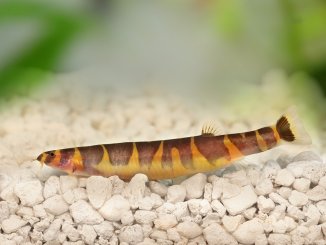
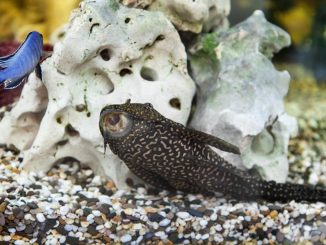
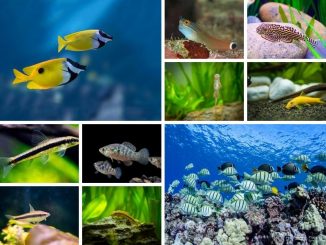
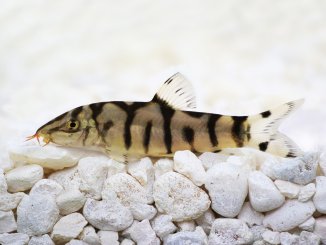
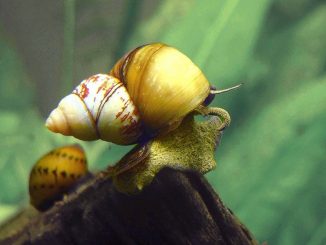
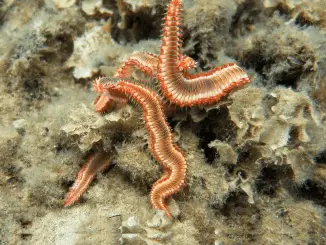
I have 2 of these beautiful little catfish in my 10 gallon tank, along with 5 ember tetras. It is my first tank and they haven’t died yet. :)
I got one and its outlived all my other fish and I judt got 2 more for him and they are thriving
I’ve just recently added 3 Panda Catfish to my tank which already has 8 Neon Tetras & 5 Glow Light Tetras. I have to say I’m loveing these little catfish, such little characters :-)
I set up an old 200l tank and placed Cory, ember terra and some of these otos in it. They’ve been good at keeping the algae levels down, but to my surprise, they’ve been breeding like rabbits and it wasn’t even my intention. From what I’ve read, I’ve been extremely lucky
These are questions rather than comments: can one Otocinclus live contentedly with peaceful community fish? Is it necessary to its health and happiness that it live in a group of its own species? I have a 10-gallon tank containing two goldfish. It is well filtered and aerated. We are enjoying the ease of caring for simple goldfish and would like to have one more goldfish and an algae eater to help with cleanup. 10 gallons is small, so one Otocinclus seems ideal. What do you think? Thank you!
10 gallon is too small for even one goldfish. they are ideally kept in a pond like koi fish. Also, the goldfish likes colder temperatures (about 22-24 degrees celcius) which is really not good for the otocinclus since they are tropical fish. otocinclus needs to be kept in well planted aquariums and goldfish are not good with plants. considering all these factors, it is probably not a good idea to get otocinclus. and also, get a bigger tank. as a rule of thumb, a single goldfish needs 20 gallons of water to thrive. so yoou need at least 60 gallons for three of these.
They should be kept in groups as mentioned above, and also I’m guessing your goldfish tank won’t be heated, and as otos are tropical fish, they aren’t really suitable. Also 10 gallons is a bit small for 2 goldfish as they grow, so maybe skip the 3rd unless you’re planning to upgrade to a larger tank when required. Maybe look into shrimp or snails as your algae eaters.
Goldfish can get pretty big, but so far as the Otocinclus, you should be able to add 3 or 4 of them. They pretty much stay out of the way and do their own thing. They do like to hang out with each other on occassion, and one would probably be pretty lonely.
While goldfish aren’t really aggressive, they can get pretty big and could hurt the otos by accident by hitting them with their big tails or getting curious and nibbling on them. If you don’t have a planted aquarium with a light, algae probably won’t be a problem at all. Otos tend to poop a lot, and so do goldfish, so the poop would probably be a problem before the algae, and all of the ammonia from the poop could easily kill the oto. Goldfish can get up to about 7 or 8 inches. It’s recommended to have 1 gallon per about 2″ of fish. Two goldfish, in that case, would require about 15 gallons to be comfortable. Also, otos prefer “tropical” temperatures that require a heater. Goldfish prefer more “room temperature” water. You can look up what the perfect temperatures for each of them are. I think otos and goldfish are a bad idea, and you probably shouldn’t add any other fish unless you upgrade your tank.
I have a 55 gallon, I have 10 angelfish, 4 harlequin rasbora, 11 neon tetras, 3 black skirted tetras, 2 pearl gourami 1 Opaline gurami, 2 Cory dories, 1 Brussel nose, 4 Otocinclus, the tank is planted, with looks of plants, I have organtic peat moss, 4″ and 1″ of eco complete, I dont use any co2 or plant food and the plants are doing great, I add water when it evaporates and tank is 79 deg, 7.4 PH, zero ammonia, zero nitrite, zero nitrate, all fish get along fine, except when angels lay eggs
10 gallons is definately too small for two goldfish you need around 30 gallons to add a third goldfish
Otos temperatures don’t make them compatible with gold fish. Gold fish like cold water 33-68F. Otos like water towards eh high end of 72-79 degrees F.
Please look up the info for goldfish. They actually get very large and require much more room than most people think. I’m pretty sure the minimum for a goldfish is 55 gallons. There is no way 10 gallons will suffice.
Just seen this , I have a group of five . They aren’t very big and fun to watch . I was told to wait to have a mature tank with some algae as that’s their diet , though I do top up with spinach leaves a couple at a time . Some say they are sensitive but I’ve lost a few and gained a few along the way and so far my favourite fish
Goldfish aren’t the best starter fish. They grow crazy big. Otos really should be in groups of at least 4
Ottos actually prefer warmer temperatures with a consistent temperature. If you do not have a heater in the tank with the gold fish ; you will need to have one with an Otto.
I wouldn’t recommend I got one before I realised there a social creature and the poor thing was extremely stressed darting about the tank constantly also thay really don’t eat that much algae at all so it probably won’t work for what you want it to gold fish are super dirty and create a lot of waste so the algae pops up and clears the water of nitrates and amona honestly I would just get a razor blade and clean the glass pane you look through and let the algae clame
The rest of the glass letting the algae grow will make your life way easier if you want less work but like 3-8 inches of dirt and a caping layer of sand 1-2 inch for your gold fish to chew up and spit out chuck some plants like pennywort or that fox tail stuff out competing the algae by having plants take up most of the nutrients from the water then the algae kinda just withers away or practically stops growing hope those helps peace I am lazy af so all my tanks are set up using the Walsall method and I won’t go back
No no no no no! Goldfish are coldwaterfish, and Otos are tropical fish. Besides, goldfish don’t like living in 10 gallon tanks(although it can be done). Goldfish produce lots of waste and may peck at your Otos.
First of all a 10 gallon tank is too small for even 1 goldfish. And otos can’t live by themselves. Have at least 4-6 otos in a 10 gallon.
The temperature requirements for both fish differ. Goldfish are messy and have a high bioload and Otos like pristine tank conditions. They may also get eaten depending on the size of your goldfish
I love Oto’s. I have had them in all 3 of my tanks since January 2014. For the first time I have had them breed, spotted 2 babies yesterday morning. Just wish they would come out from their hiding place more – the babies are out in the open more though.
Excellent and worded article.
Hi,
Could you please tell me what the Otos favorite algal culture is, to eat? I Live in NY so it has to be something I can legally purchase here. I intend to grow the algae on rocks to cycle into the tank, as aseptically as possible. My Otos won’t eat veggies or algae wafers so I am concerned about getting them adequate nutrition. I would be so grateful for any guidance you can offer. Ps. I am a biologist so I can handle any culturing tips and suggestions.
Thank you so much.
Karen
I have a 55 gallon, I have 10 angelfish, 4 harlequin rasbora, 11 neon tetras, 3 black skirted tetras, 2 pearl gourami 1 Opaline gurami, 2 Cory dories, 1 Brussel nose, 4 Otocinclus, the tank is planted, with looks of plants, I have organtic peat moss, 4″ and 1″ of eco complete, I dont use any co2 or plant food and the plants are doing great, I add water when it evaporates and tank is 79 deg, 7.4 PH, zero ammonia, zero nitrite, zero nitrate, all fish get along fine, except when angels lay eggs
I had a 20 gallon guppy tank with a cleaning crew: 3 nerites and a rubber lip pleco (only 2.5″ long as an adult). Now the guppies are gone (old age) and I am thinking populating the tank with ottos, maybe some mollies. Will the ottos be ok with my old pleco, or will they fight for territory? The tank has a gravel bottom and a fair amount of plants, and has a canister filter and aeration stone. I am working on a CO2 system to help plants grow. Temperature is usually 65-75, but used to be warmer for the guppies, with no side effect on the pleco. So we can up that.
nice articlee